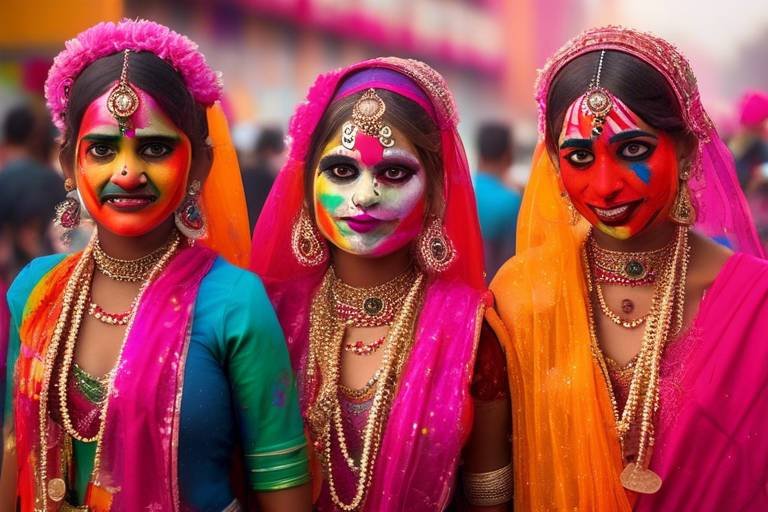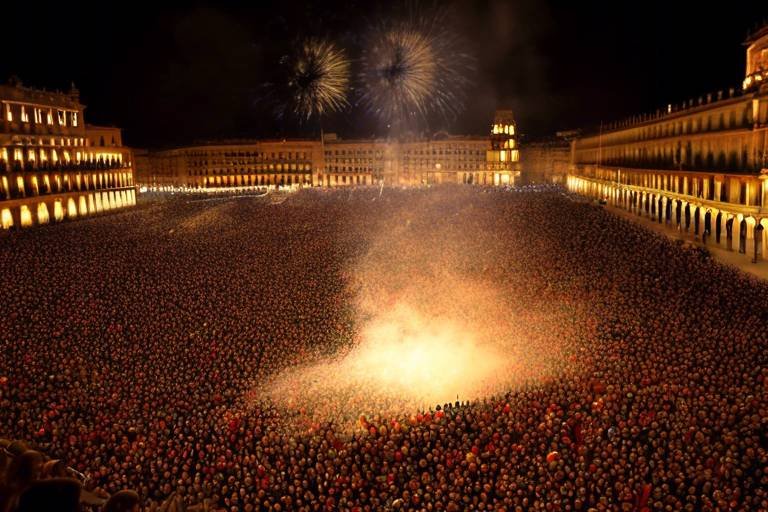How to Enjoy Korea's Chuseok Festival
Chuseok, also known as Korean Thanksgiving, is a vibrant and culturally rich harvest festival celebrated in Korea. It is a time when families come together to honor their ancestors, enjoy traditional foods, and partake in various festive activities. To fully immerse yourself in the spirit of Chuseok, here are some tips on how to make the most of this special holiday.
First and foremost, immerse yourself in the rich history and traditions of Chuseok. Understand the significance of this harvest festival, which dates back centuries and holds deep cultural roots in Korean society. By learning about the origins of Chuseok, you can better appreciate the customs and rituals associated with the holiday.
One of the highlights of Chuseok is the Charye ritual, where families pay tribute to their ancestors by setting up elaborate memorial tables with offerings of food and wine. This solemn ceremony is a time to express gratitude and respect for those who came before, fostering a sense of connection between past and present generations.
During Chuseok, take part in the tradition of Seongmyo, where families visit the graves of their ancestors to pay their respects. This practice of honoring the deceased through cleaning the graves and making offerings is a poignant reminder of the importance of family and heritage in Korean culture.
No Chuseok celebration is complete without indulging in the delectable array of traditional foods. From savory bulgogi to sweet songpyeon rice cakes, the culinary delights of Chuseok are a feast for the senses. Explore the flavors and textures of these special dishes, each carrying its own symbolic meaning and cultural significance.
Immerse yourself in the festive atmosphere of Chuseok by participating in the various activities and events that take place during the holiday. From colorful lantern parades to energetic folk dances, there is no shortage of entertainment to enjoy. Join in the Ganggangsullae circle dance, a traditional performance symbolizing unity and prosperity under the glow of the full moon.
As you celebrate Chuseok with loved ones, take the time to appreciate the beauty of Korean culture and the spirit of togetherness that defines this special holiday. By embracing the traditions, foods, and festivities of Chuseok, you can create lasting memories and deepen your connection to the rich tapestry of Korean heritage.

History of Chuseok
Chuseok is a major harvest festival and a time for families to come together in Korea. Learn about the traditions, activities, and foods associated with this special holiday.
Chuseok, also known as Korean Thanksgiving, has deep historical roots that date back centuries. The festival originated as a way to give thanks for the year's harvest and has evolved into a time of honoring ancestors and celebrating family ties. It holds a special place in Korean culture, reflecting the importance of agriculture and community.
The history of Chuseok is intertwined with the agrarian society of Korea, where the harvest played a vital role in people's lives. The festival symbolizes gratitude for the bountiful crops and serves as a reminder of the hard work put into cultivating the land. It is a time to appreciate nature's gifts and the interconnectedness of all living beings.
Throughout history, Chuseok has been a time for families to reunite, share stories, and strengthen bonds. It embodies the spirit of unity and harmony, emphasizing the values of respect for elders and honoring one's heritage. The festival's traditions have been passed down through generations, preserving Korean cultural heritage and fostering a sense of belonging.
As Chuseok continues to be celebrated with enthusiasm and reverence, its historical significance remains a testament to the enduring traditions and values cherished by the Korean people. The festival serves as a bridge between the past and the present, connecting generations and preserving the rich tapestry of Korean heritage.

Celebration Customs
When it comes to celebrating Chuseok, the customs and rituals play a significant role in honoring traditions and bringing families together. One of the central customs observed during this festive time is the ancestral memorial services known as Charye. Families gather to pay their respects to their ancestors by setting up an elaborate table with offerings of food and wine. This ritual holds deep cultural and spiritual significance, symbolizing gratitude and remembrance for those who came before.
Another important tradition during Chuseok is the practice of Seongmyo, where families visit the graves of their ancestors to perform cleaning rituals and make offerings. This act of reverence and filial piety is a way to honor the deceased and show respect for their legacy. It is a solemn yet essential part of the Chuseok celebration, connecting the living with their ancestors in a meaningful way.
Alongside these solemn customs, Chuseok also brings joy and festivity through various folk games and activities. Families often engage in traditional games like ssireum (Korean wrestling) and archery, adding a playful element to the holiday. Additionally, many people don traditional clothing such as hanbok, the traditional Korean attire, to mark the occasion with elegance and cultural pride.

Charye (Ancestral Ritual)
The Charye ritual, also known as the Ancestral Ritual, holds deep significance during Korea's Chuseok Festival. This solemn ceremony is a time for families to honor and pay respects to their ancestors through offerings of food and wine. The ritual is a heartfelt way to express gratitude and show reverence to those who have passed on, symbolizing the importance of familial ties and ancestral heritage.

Seongmyo (Visit to Ancestral Graves)
During Chuseok, one of the most important customs is the tradition of Seongmyo, which involves visiting ancestral graves to pay respects to deceased family members. This ritual holds deep significance in Korean culture as families gather at the burial sites of their ancestors to clean the gravesites, offer food, and perform ceremonies to honor the spirits of the departed. It is a time for reflection, remembrance, and connection to one's roots.

Traditional Foods
When it comes to celebrating Korea's Chuseok festival, one cannot overlook the significance of traditional foods. These culinary delights play a central role in the festivities, offering a taste of Korean culture and heritage. Among the plethora of dishes enjoyed during Chuseok, some stand out for their unique flavors and cultural importance.
One iconic Chuseok food is songpyeon, the beloved rice cake that holds a special place in Korean hearts. These delicate, half-moon shaped treats are made from sticky rice dough and filled with various ingredients like sweetened sesame seeds, red beans, or chestnuts. The process of making songpyeon is a cherished tradition passed down through generations, with families coming together to create these delectable treats during the holiday.
Another staple of the Chuseok feast is japchae, a savory and colorful dish made from stir-fried glass noodles, vegetables, and meat. Japchae's vibrant combination of flavors and textures symbolizes abundance and prosperity, making it a fitting addition to the Chuseok table.
No Chuseok celebration is complete without bulgogi, the mouth-watering marinated beef dish that graces the dining tables across Korea during this festive period. Bulgogi, which translates to "fire meat," is prepared by marinating thinly sliced beef in a mixture of soy sauce, sugar, sesame oil, and other seasonings before grilling or stir-frying to perfection.
These traditional foods not only satisfy the taste buds but also serve as a link to Korea's rich culinary heritage, embodying the spirit of togetherness and gratitude that defines the Chuseok festival.

Songpyeon (Rice Cakes)
Songpyeon, the beloved rice cakes of Chuseok, hold a special place in Korean tradition and cuisine. These delightful treats are not just ordinary snacks but are steeped in symbolism and cultural significance. The process of making songpyeon is a cherished activity during the festival, bringing families together to create these delicious morsels. The half-moon shape of songpyeon represents the wish for a bountiful harvest and a happy future. The filling inside the rice cakes varies from sweet ingredients like honey, sesame seeds, or red beans, adding a burst of flavor to each bite.

Activities and Festivities
During Korea's Chuseok Festival, the atmosphere is filled with vibrant activities and festive events that showcase the rich cultural heritage of the country. One of the most captivating activities is the traditional folk dancing, where performers clad in colorful attire move to the rhythmic beats of traditional music, captivating audiences with their grace and skill. The lantern parades that illuminate the night sky are a sight to behold, symbolizing hope and prosperity for the future. Additionally, the energetic mask dances add a touch of mystique and tradition to the celebrations, with performers donning intricate masks and costumes to tell stories from Korean folklore.

Ganggangsullae (Circle Dance)
The Ganggangsullae, also known as the Circle Dance, is a mesmerizing traditional Korean dance performed by women during the Chuseok festival. This dance holds deep cultural significance, symbolizing unity, prosperity, and the celebration of a bountiful harvest. As the moon shines brightly in the night sky, women form a large circle, holding hands and moving gracefully to the rhythmic beat of drums. The circular motion represents the cyclical nature of life and the interconnectedness of all beings.
During the Ganggangsullae, the participants wear vibrant hanbok (traditional Korean attire) and sing together in harmony, creating a sense of community and togetherness. The dance is not only a beautiful display of cultural heritage but also a reflection of the values of cooperation, solidarity, and joy that are central to Korean society. It is a moment of shared happiness and reverence for the traditions passed down through generations.
Frequently Asked Questions
- What is Chuseok?
Chuseok is a major harvest festival in Korea that is celebrated to give thanks for the year's harvest and to pay respects to ancestors.
- What are some traditional activities during Chuseok?
Traditional activities during Chuseok include ancestral memorial services, folk games, visiting ancestral graves, and participating in cultural events like folk dancing and mask dances.
- What are some traditional foods eaten during Chuseok?
Some traditional foods enjoyed during Chuseok include songpyeon (rice cakes), japchae (stir-fried glass noodles), and bulgogi (marinated grilled meat).
- Why is Chuseok significant in Korean culture?
Chuseok holds cultural significance in Korea as a time for family reunions, paying respects to ancestors, and celebrating the harvest season with gratitude and traditional customs.



















